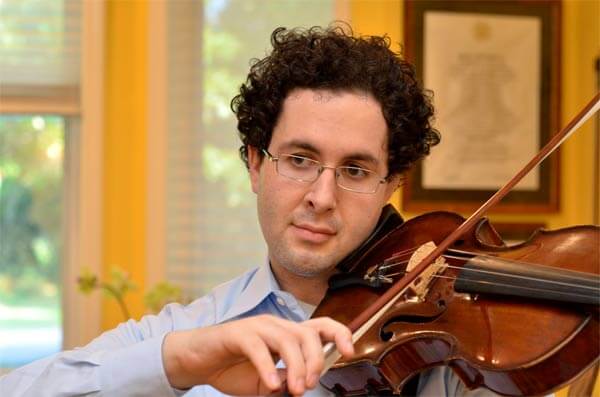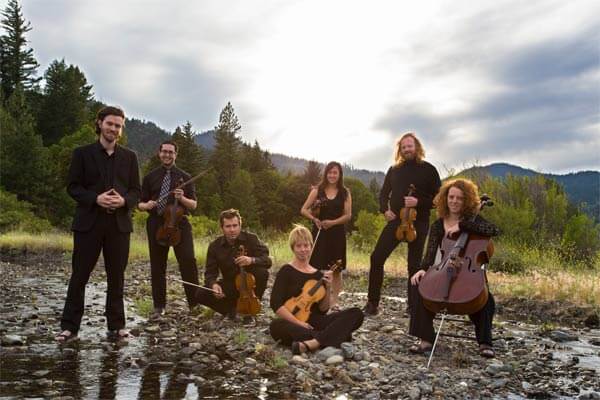
As a young musician who applied to music school with the intention of receiving a classical training, how were you personally introduced to the idea of contemporary classical music?
My first day at the Shepherd School, my Music Theory professor asked the class why the tritone was considered diabolical by early critics. The rest of the class was wise enough to remain silent, but I raised my hand, and, when called upon, answered that there was an inherent harsh ugliness to the interval. I was mocked by my professor, a composer, who dismissed my answer laughingly by declaring that he thought it was a beautiful interval. In the years since, I have decided that not only was my professor wrong to mock me because it’s rude, but he was wrong because I was right: the tritone is inherently harsh. But he was also right. The tritone is beautiful. That was an unfortunate but early exposure to contemporary musical thought.
My second exposure was much more positive. My classmate and friend Takuma Itoh, now a respected composer and professor at the University of Hawai’i, wrote a piece of chamber music–I can’t remember if it was a string trio or quartet–and asked me to help premiere it. Performing music is always an act of creation, but playing something that has never been played before has a different feeling to it. I loved it immediately. In the years since then, Takuma has written me a piece for viola solo, and one of the groups I perform with, Ensemble: Peripherie, is preparing his work entitled Pins and Needles for our next tour.
How does the chamber music component of ensemble playing translate from your classical training?
Chamber music has always been my greatest love, musically. I started playing in a string quartet when I was 10 years old, and I played in quartets throughout middle and high school, college, and graduate school. One of my summer gigs is the Trinity Alps Chamber Music Festival, and I occasionally tour with members of that group outside of northern California, where that festival is held.
Mainly, I love chamber music because it’s fun. It’s social. At any moment, I might be playing the melody or the counter-melody or rhythmic material or the bass line. Rehearsals are democratic, so, if I have an idea to improve something, all I have to do is ask, but I can just as easily sit back and do what I’m told. There’s a kind of musical compromise that goes on, a search for the right sound that leads me to play in a way that I wouldn’t if I were alone. It stretches my capabilities.
So, to answer your question, I’d say that my experiences as a quartet player translate pretty directly to contemporary music, and, really, all music. I feel that my ear gets better with each new work I study. I learn a little bit more about how to effectively rehearse each time I meet and play with a new colleague. And the more positive musical experiences I have, the better my attitude gets heading into new situations.
What is the approximate ratio of classical standards to newly composed works that you perform in an average year? How do your performances of each genre inform the other?
For now, it seems like it’s about half and half. I’m working my way through John Harbison’s Viola Notebooks (2003) at the same time as I’m learning Bach’s 5th Suite for Violoncello Solo (1720?). I just played Brahms’ Piano Quartet in c, op. 60 (1875) and his String Quintet in F, op. 88 (1882), but I also just performed John Davison’s Quintet for Trombone and String Quartet (1986) and I’m learning Takuma Itoh’s Pins and Needles (2006) and Karim Al-Zand’s Hollows and Dells (2013). Much of the time, I’m not the one deciding what I’m going to be playing. The groups I perform with send me music, and I learn it.

Many artists associated with contemporary classical music seek out academic audiences. Having recently completed Ensemble: Peripherie’s Carnegie Hall tour with performances in a variety of venues, what is your perception of the accessibility of contemporary classical music with non-academic audiences? Do you think there is a way to continue to improve this connection?
In my experience, if the music is good and the performers are enjoying themselves, the people will like it. The academic crowds are definitely enthusiastic about new music. They are dedicated to the mission. But what an average audience lacks in zeal and analytical capabilities, they make up for with open-mindedness and excitement at experiencing something new. David Gompper’s Butterfly Dance, part of our Carnegie Hall tour set-list, was popular with the New York audience, but it was also enthusiastically received by a church audience in Fayetteville, West Virginia (pop. 2,900).
In fact, small-town audiences might be the most receptive to new music. In big cities, there’s a sensory overload that can make people jaded. Hustle and bustle are not friends of deep, careful listening. Why try something new when there are a hundred variations on the thing you already know you like? Meanwhile, people without access to art and art music are hungry for it. I love playing music for folks living in rural communities.
So, part of improving the public’s perception of contemporary music involves programming more good contemporary music. They like it already, they just don’t know it yet. My personal preference is for brief easily digestible works. Even out in the quiet country, attention spans aren’t what they used to be. Expecting someone to maintain focus for more than twelve minutes is ambitious. There are geniuses capable of composing riveting larger-scale works, but, in my opinion, the longer the piece, the more likely that a portion of the audience won’t “get it”. Obviously, twelve minutes is a silly arbitrary number, and if movements contrast interestingly, multi-movement works can succeed brilliantly. But brevity is the soul of wit.
Do you think contemporary classical music can remain successful in a time where symphony orchestras are declaring bankruptcy? How does the mobility and flexibility of a group like Ensemble: Peripherie contribute to this success?
A friend of mine, a violist and professor at Willamette University named Dan Rouslin, is teaching a colloquium next semester called “Classical Music in America: Here Today… Tomorrow?” I’ve been talking with him about this very question. The issue of short attention spans (which I started thinking about in earnest in 2008 when Nicholas Carr wrote Is Google Making Us Stupid? for The Atlantic) is significant to musicians performing contemporary works. But not only are attention spans shorter, music is often listened to completely inattentively (e.g. while working out, or while driving, or while studying). Ask someone when the last time they sat down and listened to an album of any kind from start to finish without doing anything else, and it’s possible they might never have done it. And for the most part, people are listening to music that requires no effort at all to understand. Pop music is like popcorn and soda pop, dangerously delicious. We experience pop-things on autopilot.
Some artists, like Charles Ives and Andy Warhol or more recent examples like Shepard Fairey and Of Montreal take pop and put it to real artistic use, but now I’m getting off topic. The way to save art music is for everyone to advocate for it. Children and their parents should be singing in choirs and playing in bands and orchestras. Amateur musicians are the best audiences for professional musicians; no one appreciates the shine and precision of professionalism better. And smaller ensembles, groups with lower overhead costs can reach communities that have limited access. Also, watching chamber ensembles is more fun for audiences. The more interaction people see between musicians on stage, the more demonstrative our body language, the more we smile, the more likely we are to make an emotional impression.
Also, it’s beneficial for us to move out of the stuffy concert hall and into more modern settings. Classical Revolution, a group founded in San Francisco’s Revolution Cafe, with loosely affiliated chapters all over the world now, seeks to bring live classical music into bars and cafes. As the flash and bang of modern life become more and more prevalent, we have an opportunity to become novel again. The era of electricity and amplification shall give rise to a new acoustic elite. Or, at least, that’s what I hope.
























